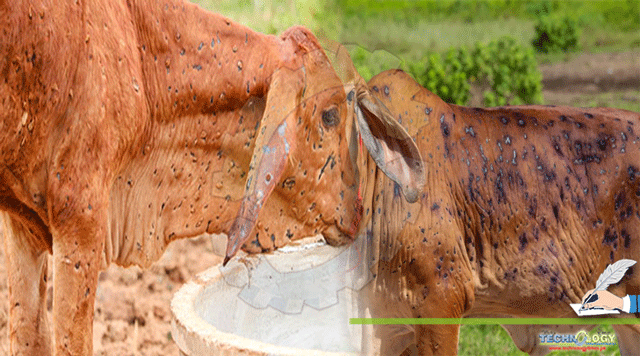Lumpy skin disease (LSD) is an acute, vector-borne, inapparent disease of Cattle and water buffalo.

Author: Ayat Fatima Malik
Corresponding Author: Ayat Fatima Malik
Introduction:
Lumpy skin disease (LSD) is an acute, vector-borne, inapparent disease of Cattle and water uffalo. This disease is transmitted by different vectors and blood-feeding arthropods. LSD causes economic losses due to its effect on hiding quality, loss of meat and milk production, and effect on international livestock trade. There is no specified treatment for LSD. LSD is not a zoonotic disease, this does not transmit from animals to humans.
Causative Agent:
A virus of the genus Capripoxvirus causes LSD. Capri poxvirus is sensitive to sunlight but in shadow or dark conditions like sheds, it can preserve for many months.
Epidemiology:
Morbidity and Mortality Rate:
It depends on the hygienic condition, geographical area, climate changes, nutritional status, and immune response of animals. The Morbidity rate is 5-45% and the Mortality rate is 1-5%.
Susceptible Animal:
Cattles and buffalos are the most susceptible animals to LSD. No other domestic ruminants become infected with LSD.
Transmission:
The transmission occurs by arthropod vectors like ticks, mosquitoes, and biting flies. Female Aedes Aegypti, and Culex Mirificens mosquitoes, stomoxys Calctrians, and Haematopota spp. Biting flies, Culicoides, and male ticks Riphicephalus appendiculatus and Amblyomma hebraeum, play important roles in transmission.
LSD can also be transmitted by direct and indirect transmission by communal grazing and watering points. In infected animals, the LSD virus is present in their semen, milk, nasal and lacrimal secretions. LSD outbreaks are associated with warm and cold weather conditions. This disease increase with the increase in the population of vectors and decrease with the decrease in the population of vectors.
Transmissible disease from Animals:
LSD does not transmit from animals to humans, but only transmit from animals to animals. LSD is not dangerous for humans. The milk and the meat of infected animals are usable for humans, LSD does not transmit from milk and meat.
Clinical signs:
Clinical signs of LSD developed after the incubation period of 4 – 12 days. The temperature of the diseased animal raised to 40 degrees centigrade. Animal show lacrimation, anorexia, dysgalactia, nasal and pharyngeal secretions, feel depression, and hesitation to move. In infected animals, lesions are developed in the epidermis, dermis, and sub-cutis. Lesions are also developed in the larynx, trachea, and alimentary canal, edematous which lead to acute gastroenteritis.
Sometimes lesions peel off and produce a thick hole in the skin, bacteria may invade the hole. In LSD, the limbs of infected animals are swelled. Lesions on the teats of infected animals may drop off and susceptible animals to mastitis. Animal reduced feed intake, slow rise in rectal temperature, swollen pre-scapular and pre femoral lymph nodes, and developed rough skin coat. The head, neck, udder, and limbs are pre-directional sites. Sometimes, bulls become temporarily and permanently infertile and abortion is caused in pregnant cows.
Recovery from this acute infection is slow due to weakness, secondary pneumonia, mastitis, and necrotic skin plugs due to these vectors revolving around the infected animals and shed produce a deep hole in hiding.
Laboratory Diagnosis:
- Conventional PCR is a less expensive and quick method for the detection of Capri pox virus. For this diagnostic method, Skin nodules, scabs, saliva, nasal secretion, and the blood sample are used.
- Immunohistochemistry is used to recognize the virus.
- Electron microscopy is also used to identify the virus.
- Some Serological tests are also used for the detection of LSD like Virus Neutralization test, Fluorescent antibody test, Western blotting, Enzyme-linked immunosorbent assay, Immunoperoxidase monolayer assay and Agar gel immunodiffusion test.
Treatment:
There is no particular treatment for LSD because it is caused by the virus. But antibiotics, anti-inflammatory drugs, and vitamin supplements are given to the infected animal to treat secondary bacterial, infection, fever, and inflammation.
Vaccines:
Only live attenuated vaccines are effective and used for protection against LSD virus. The homologous vaccines are currently commercially available. Insecticidal are effective against LSD because insecticidal reduce the rate of bites and have an effect on the probability of infection.
Prevention and control:
These prevention measures should be taken to control LSD.
- Movement of diseased animals should be avoided.
- Proper disinfection should be taken.
- Mosquito net should be used when cattle are kept permanently indoors.
- Live attenuated vaccines should be given to animals.
- Control of insects is effective against LSD, so the use of insecticides are used.
- Proper hygienic measures should be taken for infected animals.
- Proper cleaning should be taken.
- LSD should be controlled by vaccination or by immunoprophylaxis.
Conclusion:
The recent outbreak of LSD is causing serious loss to dairy farmers, and leather industries and effect economics. And no particular or effective treatment is available for LSD. The only way to control LSD is to the control vectors population. Proper management, proper hygienic measures, and preventative measures can save our economy.